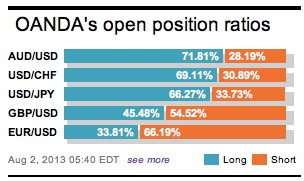Today’s key event, US non-farm payrolls, will determine the direction of the dollar and all the other asset classes. The stronger than expected US data that’s been released over the past week has definitely raised market expectation to new heights for this morning’s labor release. With the Fed not including any “tapering bias” in their mid-week statement, they have managed to increase the influence that the market will be placing on the labor market data between now and their mid-September meeting. Strong labor market data today would be broadly supportive of a potential September taper. The fixed income asset class will be the most active of classes if the market is surprised greatly in either direction by the employment headline.

This non-farm payroll, at a minimum, is expected to post another solid increase of +185k in July. However, the market seems to have set its sight higher and the final print would have to exceed +200k if it wants to push the ‘mighty buck’ and US treasury yields higher. Investors are also looking for the unemployment rate to tick down to +7.5% from +7.6%. A number worse than +160k should be met with investor disappointment – the USD and US treasury yields would likely move lower as a result.
For specific currencies, the USD/JPY pair could possible end being the most impacted if there is a surprise result in a shift of Fed expectations. Analysts would argue that this is due to the currency pair’s strong correlation with US treasury yields and the expectations by investors that the treasury market will see the biggest reaction to the jobs market.

If today’s NFP report happens to print on the strong side, a rise above +200k, and an unemployment rate easing down to +7.5%, then US 10’s are expected to back up through key resistance of +2.75%. Such high yields would likely push USD/JPY north of the psychological ¥100 and towards ¥100.50. Conversely, if the headline comes in sub +160k, and despite an unemployment rate improving to +7.5%, US 10’s could trade below +2.60-55%, thereby pushing USD/JPY to revisit sub ¥98.50 and trade towards ¥98.00.
Other US data releases are expected to reveal that nominal consumer spending should have risen in June by +0.4%, while personal income should advance +0.6%, thereby boosting the US savings rate to +3.4%. Consensus expects the headline PCE price index to be up +0.4% in June, with core up +0.1% – very much in keeping with the soft year-on-year trend.

Other data this week revealed that the global PMI surveys continued to improve in July. The aggregate global manufacturing PMI index rallied to 51.2 from 50.3 in June. Digging deeper, analysts note that the forward-looking new orders subcomponent seems to be following a similar pattern and increased to 52.1, the highest level in five-months. The July global aggregate is solid proof that the results from the developed markets are more than offsetting the weakness in the emerging sector. Investors seem now to be expecting that global IP growth momentum will expand at a faster pace in H2, somewhere in the region of +5.4% from +3.4% in H1. Significantly, analyst’s calculations include a market expectation that a Chinese slowdown will not impede a Euro and North American upswing.
In conclusion, strong convictions do have their limitations. With such market enthusiasm for recent strong data, an even slightly below consensus US job print could actually prove hugely disappointing. This scenario would be consistent with a USD pullback, especially against the JPY and AUD (a currency in danger of being strongly oversold), but also across emerging markets. A reading in line with consensus or above, on the other hand, would cement expectations of a September taper, pushing the USD higher against most of its trading partners.

On the commodity front its not too much of a market surprise to see that gold futures have fallen close to -1.2% since this week’s mid-week FOMC meet, especially as the stronger U.S. economic data has strengthened the case for QE tapering in September. On the US fundamental front, Q2 annualized GDP growth was +1.7%, July ISM manufacturing index was also higher at 55.4, while the weekly initial jobless claims fell -19k to +326k. Also aiding the gold bears strategy was the World Gold Council (WGC) releasing a report urging gold investors “not to overestimate the impact of the rising interest rates and the tightening of the monetary policy in the U.S. on gold prices.” Again this morning, ahead of the US jobs report, the yellow metal has faced further selling in both overnight regions. In a matter of hours the market gets to see if the investor is required to take the foot off the gas and apply some USD buying caution.

Other Links:
Aussie Falls Below Significant 90 Line
Dean Popplewell, Director of Currency Analysis and Research @ OANDA MarketPulseFX
This article is for general information purposes only. It is not investment advice or a solution to buy or sell securities. Opinions are the authors; not necessarily that of OANDA Corporation or any of its affiliates, subsidiaries, officers or directors. Leveraged trading is high risk and not suitable for all. You could lose all of your deposited funds.


